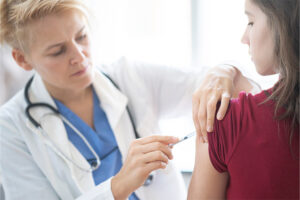Infectious Diseases
Adolescent Vaccinations
Encouraging Vaccinations Among College-Aged Individuals
Our featured expert notes several opportunities to support vaccination acceptance and uptake among college-aged individuals. Establishing a “culture of vaccination” is an important part of helping young adults optimize their protection against vaccine-preventable diseases.
Definitions vary, but a range of ages between 10 and 19 years is often considered when discussing adolescent vaccinations, a range that notably includes college-aged individuals. Vaccines are recommended to protect against diseases that are most relevant for each age group. In the preteen years, waning immunity of infant vaccines, such as those providing immunity to diphtheria, tetanus, and pertussis, is an impetus for these recommendations. Alternatively, vaccines may be recommended for preteens and teens to optimize protection against diseases that are associated with an increased exposure risk during adolescence and young adulthood, such as human papillomavirus and meningitis. Other vaccines are recommended annually, such as the seasonal influenza vaccine and the COVID-19 vaccine, to protect everyone against epidemic infections, including adolescents.
The college-aged population is a critical group to consider when discussing routine vaccinations. Just as we do with younger age groups and their parents, creating a culture supporting routine vaccines for college-aged students can have long-term positive effects on vaccine acceptance and compliance. These young adults are out in the world, making their own decisions. Like all of us, their decision making can be influenced by many factors, including their upbringing and how their families view vaccination. However, even young adults who come from a family with a strong culture of vaccination might not go to get their seasonal influenza vaccine, for example, while away at college. Or they may not be aware of updates in vaccine recommendations, including current recommendations for catch-up vaccination, and so, they may not know to get certain vaccines. Examples of these are human papillomavirus and meningococcal vaccination recommendations for adolescents and young adults.
I see responsibilities as being shared, with some responsibility falling to parents, some to colleges, and some to the students themselves. Parents can continue to have a role in that they are in communication with their adolescents or young adults, and they can ensure that they are up to date with annual vaccinations, boosters, and/or additional doses that are recommended for their age group.
Regarding a college’s responsibility, entry requirements for vaccination are extremely helpful, as is access to student health clinics, where students can easily obtain information on and receive their recommended vaccines. At present, most colleges request information regarding a student’s vaccination status against hepatitis B and meningococcal diseases. Colleges can proactively play a role by engaging with their students to educate them about vaccines and to ensure that they have access to all of the recommended vaccines.
Vaccination ownership should also fall on the students themselves, who are able to make their own health care decisions once they turn 18 years old. Becoming vaccine champions (ie, people who may be part of the student body but work with the campus health clinics or the student media) is one way to support vaccine prevention efforts on campus. These champions can help develop materials about vaccines and can disseminate information on vaccine recommendations and where to receive them throughout the campus.
A special point for consideration in the college-aged population includes the potential consequences of contracting vaccine-preventable illnesses that could result in outbreaks. While it might not be considered serious in young adults, influenza can be quite disabling. Flu season may coincide and interfere with students taking final exams or participating in various extracurricular activities at the end of their academic term, and influenza can still be circulating when the student body returns in January after the winter break. Adolescents and college-aged populations are also at risk for life-threatening diseases such as meningococcal disease. We have had many recent examples of this. In fact, the initial approval of meningococcal serogroup B vaccines was, in part, a response to outbreaks that occurred in various colleges in the United States. We know that meningococcal infection can be easily transmitted from one person to another in small groups, dormitories, bars, and parties, for example, all of which are common settings for college-aged students.
Caleb S, Thompson D, Haimowitz R, Ciotoli C, Dannenbaum M, Fu LY. How colleges intervene to increase student body vaccination coverage. J Am Coll Health. 2022;70(2):428-435. doi:10.1080/07448481.2020.1752698
Child & adolescent immunization schedule. Centers for Disease Control and Prevention. Updated April 27, 2023. Accessed November 9, 2023. https://www.cdc.gov/vaccines/schedules/hcp/imz/child-adolescent.html
Lee D, Rundle-Thiele S, Wut TM, Li G. Increasing seasonal influenza vaccination among university students: a systematic review of programs using a social marketing perspective. Int J Environ Res Public Health. 2022;19(12):7138. doi:10.3390/ijerph191271380
Menz BD, Modi ND, Sorich MJ, Hopkins AM. Health disinformation use case highlighting the urgent need for artificial intelligence vigilance: weapons of mass disinformation. JAMA Intern Med. 2023 Nov 13. doi:10.1001/jamainternmed.2023.5947
Real FJ, Mesiman A, Fleck L, Klein M, Kahn JA, Rosen BL. Evolution of education-focused digital interventions to support human papillomavirus vaccination. Acad Pediatr. 2023 Nov 10;S1876-2859(23)00416-3. doi:10.1016/j.acap.2023.11.012
Twelve COVID-19 vaccination strategies for your community. Centers for Disease Control and Prevention. Updated November 29, 2022. Accessed November 9, 2023. https://www.cdc.gov/vaccines/covid-19/vaccinate-with-confidence/community.html











